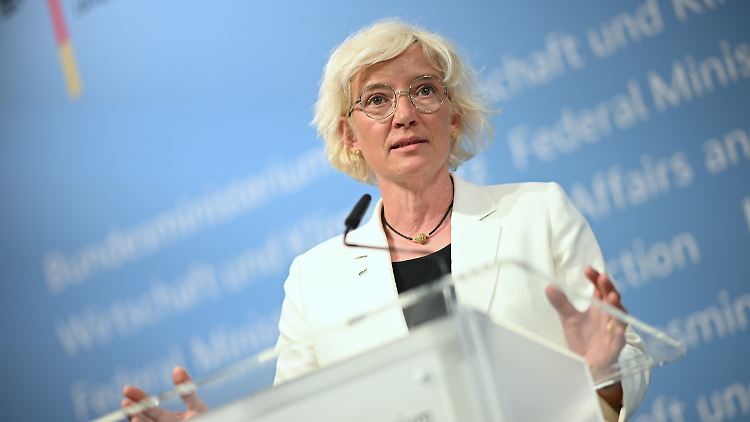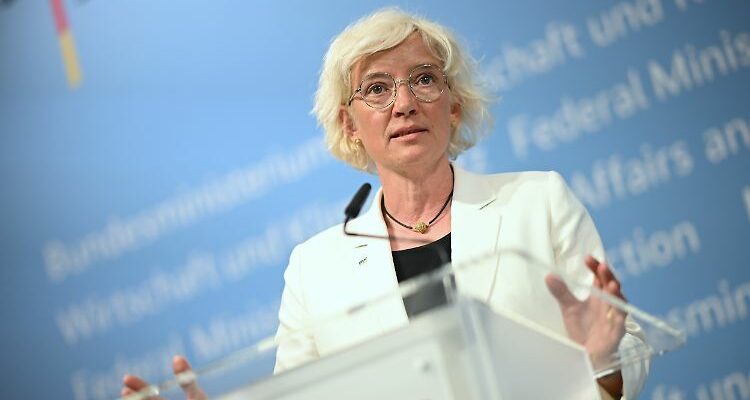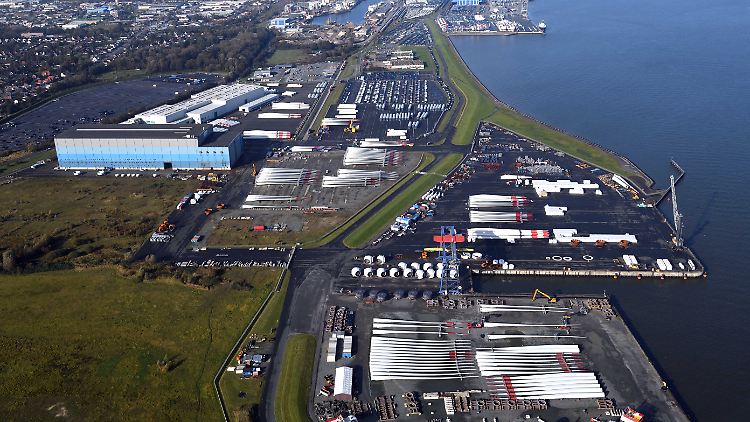Germany wants to build offshore wind farms with a capacity of 30 gigawatts by 2030 and even 70 gigawatts by 2045. The industry estimates that this would require 7,000 wind turbines the size of the Eiffel Tower. However, there is currently a lack of port space and special ships for this expansion. Cuxhaven plays a key role. Bärbel Heidebroek, the President of the Federal Wind Energy Association (BWE), explains in ntv’s “Climate Laboratory” why the Lower Saxony port is a bottleneck for German expansion at sea, but also on land and thus for the entire energy transition. Another problem is the subsidized Chinese competition. Without clear competition rules, the European wind industry could face the same fate as the solar industry, warns the BWE boss. The horror scenario is dark: If China gets its way, the Chinese leadership could later control Germany’s energy supply.
ntv.de: How can it be that there is a lack of port space for wind power at sea?

This is not fair competition, says BWE President Bärbel Heidebroek about the Chinese wind power competition.
(Photo: picture alliance/dpa)
Bärbel Heidebroek: Of course, the port areas have not decreased, we simply need more and more capacity. We don’t just need port expansion for offshore purposes, i.e. for wind power at sea. Most of the rotor blades for onshore wind turbines also come to us by water: 80 percent of these onshore blades land in Cuxhaven. The quantities and the rotor blades themselves have increased significantly and the port expansion has not kept up.
Who missed that? Wind energy is not a brand new technology.
No one. The energy transition is simply gaining momentum and now the associated infrastructure needs to get going. Especially in the offshore sector, neighboring states have helped us with their ports for a long time. As wind expansion increases across Europe, they now need their own capacity and are no longer available. And the fact that we are now installing 80-meter-long rotor blades on land has really only happened in the last few years. The wings used to be made in Germany, so the port wasn’t a bottleneck. Due to the dip in the expansion of wind energy, a lot of production has shifted to other European countries in recent years, so that the ports now have a different role.
Among other things, the NDR in March reportedthat the Cuxhaven port is to be expanded for 300 million euros. Is that the solution?
This is very good news and part of the solution, because Cuxhaven is the only German port that already has an expansion permit and can get started. But of course he can’t be the only one, because we don’t have a plan B for the energy transition. Investments are also needed in Bremerhaven and Rostock so that we can maintain the entire logistics chain.
Why did it take so long? The plans for expanding wind power at sea are a little older.
In Cuxhaven it was a matter of financing. Port expansion is normally a state matter, but rotor blades for all of Germany are delivered there. That’s why our position was: The necessary infrastructure is also a federal responsibility. The federal government is now providing a grant of 100 million euros. Without him we couldn’t have done it. You can probably imagine that the agreement was made more difficult because money is currently tight in the federal budget. In this respect, a lot of lobbying had to be done to convince everyone that the port expansion is a necessity for the entire energy transition and that this project should not fail because of this bottleneck.
When does the expansion begin?
Next year.
And does that fit with the goals for wind power?
It is ambitious but achievable. Nevertheless, the port expansion must begin as quickly as possible so that European wind expansion can be sustained in the long term. If I want to switch to renewable energy, I need infrastructure. I firmly hope that everyone now knows: it doesn’t work without it. That would be like me wanting to build wind turbines, but not being allowed to transport the cranes on the roads. That does not work.
A nice keyword: Not only are port areas missing, but also large ones Special ships with cranes for installation at sea. Where are they come from?
This is a normal process in an economy: If it is clear that the facilities should be built and I have the necessary infrastructure, a shipyard will be found to build these ships. The economy will solve this on its own, as long as the politically defined framework conditions are suitable, stable and predictable. Then the business case is made and the business is worthwhile.
But the components for new wind turbines are ready much faster than new ships. Doesn’t the federal government have to go to the shipyards and say: start building, we guarantee the orders! In the case of Ukraine, it was known for many months that it urgently needed ammunition. Nevertheless, the EU has clearly failed with its promises.
The federal government does not have to guarantee the orders, but the expansion goals must remain clear. Today we still suffer from the ups and downs of the last governments. It will work in the private sector if goals are not questioned. Now new areas are being designated, surcharges are being made, and the port expansion is coming. The first step for offshore expansion has been taken. Now the supply chain can follow suit. Nobody builds ships if they don’t know whether the necessary projects and ports are there. Of course, it can happen that this chain stalls again, because the energy transition practically stopped under the previous government. It’s like a steam locomotive that’s now getting going again. It doesn’t accelerate like a Ferrari.
There is also currently a big debate about fair competition with China. The EU is investigating the areas of electric cars and the solar industry, but is also looking at Chinese wind turbine manufacturers. There are punitive tariffs and import restrictions on the table. Are you afraid of problems from this direction?
Punitive tariffs are rarely a good idea because they lead to a trade war. It is clear that China produces under different conditions. The Chinese state heavily subsidizes its companies. This is not fair competition. European wind manufacturers cannot compete with this. We have to be careful that they are not replaced by Chinese companies like the solar companies. But there is a European answer, the so-called Net Zero Industry Act, which states: 40 percent of all green technologies must be made in Europe. There is currently a discussion about how the regulation must be designed so that the wind industry receives fair conditions.
Is there already a bottleneck emerging with certain components that could become a problem?
As with all technical devices, there are components that primarily come from China. We should bring at least part of the production back to Europe. I don’t want to imagine a world in which China can take German wind turbines offline and control our energy supply.
That would work?
Every manufacturer potentially has access to their wind turbines. Manufacturers must also have this access because the system must be maintained or shut down in the event of a bottleneck or malfunction. If you imagine that there are only Chinese wind turbines in Germany, China could – to put it bluntly – press a red button and it would be dark. That’s why we need clear rules like those in telecommunications: China must not dominate and control these. It should be the same in the area of cybersecurity for wind turbines.
Clara Pfeffer and Christian Herrmann spoke to Bärbel Heidebroek. The conversation has been shortened and smoothed for better clarity. You can watch the entire conversation in the podcast “Climate Laboratory” listen.
What really helps against climate change? Climate laboratory is the ntv podcast in which Clara Pfeffer and Christian Herrmann put ideas, solutions and claims through their paces. Is Germany an electricity beggar? Is the energy transition destroying industry and jobs? Why do so many people expect their economic decline? Why are always the green fault? Are sea eagles really more important than wind turbines? Can nuclear power save us?
The ntv climate laboratory: half an hour every Thursday that informs, has fun and cleans up. At ntv and everywhere there are podcasts: RTL+, Amazon Music, Apple Podcasts, SpotifyRSS feed
You have questions for us? Write an email to [email protected] or contact Clara Pfeffer and Christian Herrmann.

